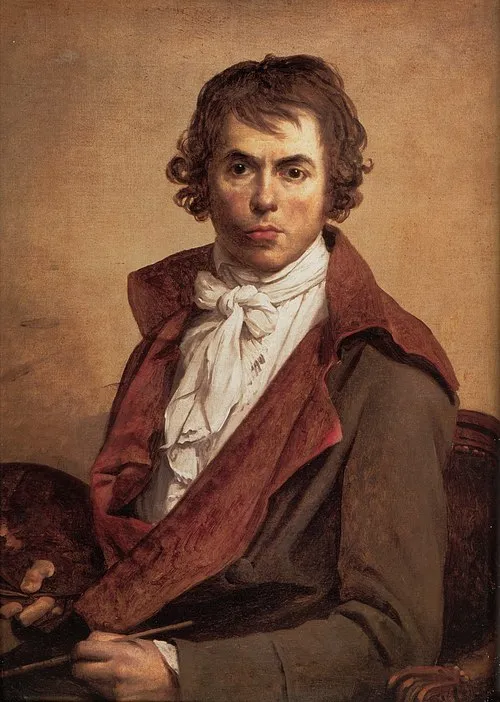
Name: Jacques-Louis David
Birth Year: 1748
Death Year: 1825
Nationality: French
Profession: Painter and Illustrator
Art Movement: Neoclassicism
Notable Works: The Death of Socrates, Oath of the Horatii, Coronation of Napoleon
Jacques-Louis David: The Man Who Shaped the Brushstrokes of Revolution
Born in the heart of Paris in 1748, Jacques-Louis David emerged not merely as a painter but as a potent symbol of a tumultuous era. His journey began like many others amidst the vibrant chaos of 18th-century France but it quickly transformed into something extraordinary. The young artist, whose talent was evident even in childhood, found himself enveloped in the artistic currents swirling around him. However, it was not just his skill with a brush that would define his legacy; it was how he intertwined art with the very fabric of political change.
As he honed his craft at the prestigious Académie Royale de Peinture et de Sculpture, he became captivated by classical ideals and the works of masters like Raphael and Caravaggio. In this crucible of artistic development, David's vision began to take shape. His early works were marked by an adherence to neoclassical principles characterized by clarity, order, and virtue. Ironically, these very principles would later serve as tools for propaganda during one of history’s most radical transformations the French Revolution.
The spark that ignited this transformation came in 1789 when revolutionary fervor swept through France like wildfire. David stood at a crossroads; he could either remain an apolitical observer or dive headfirst into this revolution that promised both upheaval and hope. Choosing the latter path was pivotal not only for his career but for the art world itself.
His groundbreaking work “The Oath of the Horatii” (1784) served as an unambiguous statement about patriotism and sacrifice during these trying times. With its strong lines and stoic figures reminiscent of Roman virtues, this painting resonated deeply with viewers who were grappling with their own identities amidst societal chaos. Perhaps more than any other work from this period, it encapsulated what many deemed necessary for their fight a sense of duty to one's country over personal desires.
Yet success did not come without its challenges; despite his initial acclaim from monarchists who commissioned artworks celebrating royal grandeur, David's staunch support for revolutionary ideals ultimately alienated some patrons while endearing him to others within revolutionary circles.
The turning point arrived when King Louis XVI fell victim to guillotine justice in 1793 a moment that would leave indelible marks on both France and David’s artistry alike. As tensions mounted across Europe against France’s burgeoning republics invoking fear among monarchies David seized upon this atmosphere ripe for ideological expression through visual storytelling.
His portrayal titled “Death of Socrates” epitomized such fervor: there stood Socrates defiantly drinking poison while surrounded by distraught disciples a powerful metaphor reflecting those brave enough to stand against tyranny! This artwork became emblematic not just within French borders but far beyond them; many historians argue that such images profoundly influenced public opinion toward progressive thought across Europe itself!
The irony lies here: Although propelled into fame due to political circumstances beyond control David also risked losing everything! With changing tides brought forth by subsequent leaders including Napoleon Bonaparte he navigated treacherous waters carefully balancing personal ambition against greater national identity struggles!
A Brush Strokes Revolution
As Napoleon rose ascendant over Europe following his coronation on December 2nd, 1804 one can only imagine what passed through David’s mind... Here lay an opportunity ripe with possibility! Gaining favor directly from Bonaparte meant artistic commissions wouldn’t dwindle under strict censorship which often plagued other artists pursuing less favorable themes at time...
Ironically however as much as Jacques-Louis enjoyed privileged access directly aligned alongside power it demanded acute attentiveness toward shifting loyalties given fluctuating tides politics presented regularly… Perhaps what fueled such dedication stemmed back towards prior battles waged where allegiance mattered deeply?
An Artistic Legacy
This blend between artistry & politics culminated perfectly culminating ‘The Coronation Of Napoleon’ showcasing sweeping narratives filled intricate details conveying everything celebratory grandeur surrounding emperor ascendance yet simultaneously provoking deep introspection regarding authority figures' role shaping lives citizens every day basis… Could history repeat? Who knew?!
A Creative Evolution
Later Life - A Retrospective Look:Despite initial acclaim under Bonaparte's rule post-1815 events led series shifts including restoration Bourbon monarchy featuring attempts stifle any echoes rebellion artistically expressionately flourishing previously unchecked grounds… A fate several contemporaries experienced alongside too!Yet even amidst trials endured firsthand via governmental crackdowns imposed limitations still struggled persevering onwards creating notable pieces including ‘The Death Of Marat’ wherein celebrates sacrifice witnessed depicted martyrdom undeniably poignant way immortalizing revered revolutionary icon forevermore popular imagination people today.Your thoughts? Who knows really!? Conclusion - An Enduring Influence:

